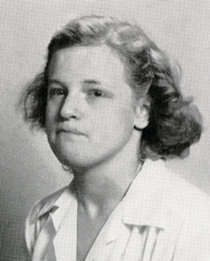The mighty Martha Wren Briggs ’55
September 17, 2019
By
Noah Robertson '19

Martha Wren Briggs '55
The legacy of the late Martha Wren Briggs ’55 continues. Though she passed away on July 2, 2017, her impact at William & Mary has never been stronger. In fact, part of it is in the process of being built.
A writer, librarian and art historian, Briggs was involved in the liberal arts during and after her time at William & Mary. She received her master’s in art history from the Institute of Fine Arts at New York University, published multiple academic articles and was an expert on American stained glass master Louis Comfort Tiffany. She even owned a publishing firm and wrote a series of children’s books based on the Jamestown-Scotland Ferry.
Briggs struggled with cerebral palsy throughout her life, but even when the condition became more difficult, her mind never slowed down. Her friends remember the notoriously difficult holiday quizzes she would send out each year, just for the simple pleasure of stumping them.
And while her legacy survives in her research and writing, it also continues through her giving. At William & Mary, she helped create opportunities for future students and scholars to follow in her footsteps.
In 2016, the Lake Matoaka Amphitheatre was renamed in her honor to recognize her gifts to restore the theatre to its original glory and make it accessible to all visitors. Every part of the amphitheatre, from its stage to its seating, exists because of her philanthropy, which she insisted be anonymous for years. Briggs felt a deep connection to the amphitheatre through her own history — she enjoyed many of the performances staged there and first decided to attend William & Mary while sitting on the brick wall at the rear of the amphitheatre.
Students now use The Martha Wren Briggs Amphitheatre at Lake Matoaka for their own artistic expression and to enjoy the creativity of others. A typical evening there could feature an a cappella concert, a dance performance or groups of students gathered to study or spend time together, sitting on the soft grass terraces. Overlooking the lake, it is a place for peace, to be together or to think alone.
The amphitheatre might be the first significant physical manifestation of Briggs’s legacy on campus, but it will hardly be the last. The world-renowned architecture firm Pelli Clarke Pelli is currently working on designs for The Martha Wren Briggs Center for the Visual Arts, which will house an expanded Muscarelle Museum of Art, with additional galleries to showcase both permanent and temporary exhibits as well as educational and exhibit support spaces. The center will support the kind of creative thinking that Briggs encouraged throughout her life.
Of course, The Martha Wren Briggs Center for the Visual Arts would not be possible without Briggs herself. She answered the call with a donation of more than $30 million to support the revitalization of the arts facilities at William & Mary. Her gift will help lay the building’s foundations and establish an endowment for its support as well as one for the amphitheatre, but her impact goes far beyond bricks and mortar. Her gift also supports educational program collaborations in the field of visual arts between schools and departments across the university.
Briggs lived right across the street from the Muscarelle for decades. She became friends with former Muscarelle Director Aaron DeGroft ’88, who remembers giving her a gift basket each year at her birthday with an orchid inside — she kept every flower.
“Her gift will be invaluable to so many faculty and students — and the public alike — who are just as passionate about the arts as Martha was her entire life,” said DeGroft. “It is not often that you come across someone who has the perfect blend of wit, humor, compassion and strength that Martha embodied. She was an inspiration to the entire William & Mary community and we will be forever grateful to Martha for her generosity.”
The visual arts center will move student opportunities for creative thinking beyond observation and into collaboration. It is collective creativity, and that is the strongest monument to Martha Wren Briggs.
Musical groups ranging from the Virginia Symphony Orchestra to the alternative rock band Parachute have performed at the amphitheatre. The expanded Muscarelle, which will now reside in the visual arts center, has featured exhibitions from Caravaggio, Da Vinci, Botticelli and Michelangelo in recent years. With artists like those, Briggs is in good company.
Her lasting contributions are seen not only in the buildings that will bear her name but in the students’ lives she changed, and in her small acts of service, for which she won the Alumni Service Award in 2008. Her memory will continue through the new art exhibitions in The Martha Wren Briggs Center for the Visual Arts, through the undergraduates in the library studying with the help of her scholarships, and through the music and conversation of evenings at the amphitheatre. Her name will be remembered, and no one at William & Mary will forget what Martha Wren Briggs has given them.